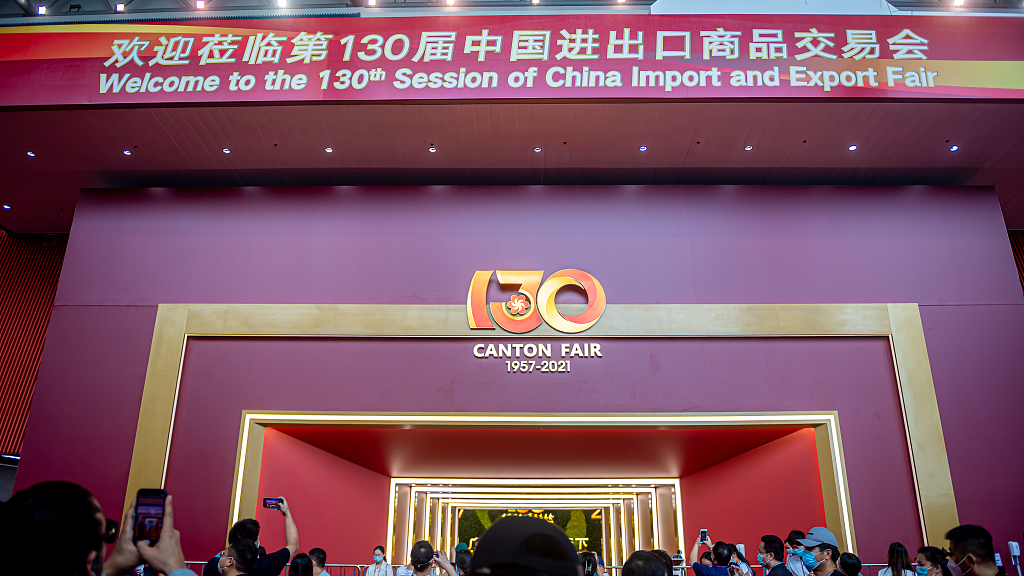
The 130th session of China Import and Export Fair in Guangzhou, Guangdong Province, south China, October 15, 2021. /CFP
The 130th session of China Import and Export Fair in Guangzhou, Guangdong Province, south China, October 15, 2021. /CFP
Editor's note: John Gong is a professor at the University of International Business and Economics (UIBE) and a research fellow at the Academy of China Open Economy Studies at UIBE. The article reflects the author's opinions and not necessarily the views of CGTN.
Like many great things, the Canton Fair, also known as the China Import and Export Fair, had a humble beginning. When launched in the city of Guangzhou on April 25, 1957, it had only 13 exhibiting companies, 1,223 visitors and a total transaction volume of a bit over $17 million.
Today, at its 130th session, the Canton Fair has blossomed into the oldest, largest and the most important exports and imports trade show in China. And amidst all the difficulties and challenges in the age of pandemics, this year's Canton Fair will be held offline as planned, in addition to an online component.
The Canton Fair is usually held twice a year, in spring and autumn respectively. After 64 years and 129 sessions, now the exhibition floor space has grown to 400,000 square meters, only behind the Hanover Fairground in Germany and the World Market Center Las Vegas in the United States. Without a doubt, it is now the world's third largest trade fair.
This year, 26,000 companies will showcase their products, and over 200,000 visitors from 210 countries will tour the fair, expecting to make purchases worth over $30 billion within a week.

A scene inside the 130th session of China Import and Export Fair in Guangzhou, Guangdong Province, China, October 15, 2021. /CFP
A scene inside the 130th session of China Import and Export Fair in Guangzhou, Guangdong Province, China, October 15, 2021. /CFP
Aside from the obvious big dollar sign the fair organizers are eyeing, there are also a few things that are unique and purposeful this year that the organizers have provided to demonstrate a bit of corporate social responsibility.
This year features a special exhibition space dedicated to China's rural vitalization effort, where specialty products from companies in rural communities are displayed at discounted prices. These are mostly companies making industrialized agricultural products from areas benefiting from the Chinese government's poverty elimination initiative. Altogether 838 companies have taken advantage of this offer.
The fair organizers have also set aside some sizable space dedicated to the new energy initiative. More than 70 companies are displaying new low-carbon, low pollution and energy-saving green products in areas of solar power, wind power and biofuels.
By highlighting a window into China's environmental protection efforts and in response to climate change, the Canton Fair facilitates in its own way the better diffusion of new Chinese technologies that help save the Earth.
The history of the Canton Fair epitomizes how this country has made great strides over the years in trade with the rest of the world. In a way, it is a success story of people and companies dashing to the global market via entrepreneurship and hard work, considering in the late 1950s when the Canton Fair was first started, China's foreign trade was outright negligible.
Today, China is the world's largest trading nation, being the largest exporter and the second largest importer. Partly due to accession to the World Trade Organization and partly due to Chinese people's entrepreneurial drive, China has gone from a minuscule player with less than one percent of global trade before 1990 to nearly 15 percent of total global trade last year, ahead of the United States at 8.1 percent and Germany at 7.8 percent.
Judging from the trade statistics for the last two quarters, it is clear that China's share of global trade is expected to continue to rise, and so will the Canton Fair's transaction volume. After all, China has always been an important trading nation.
(If you want to contribute and have specific expertise, please contact us at opinions@cgtn.com.)

